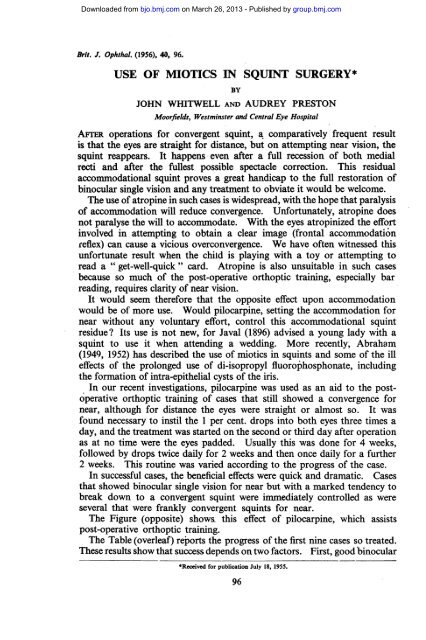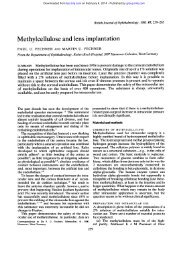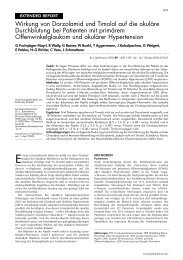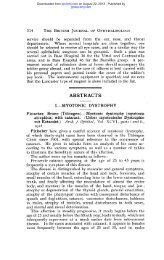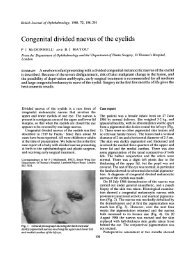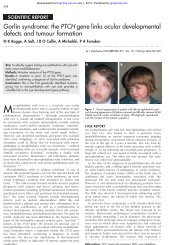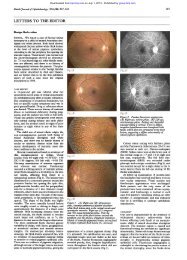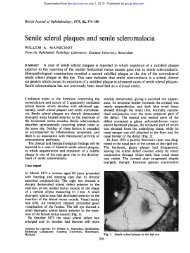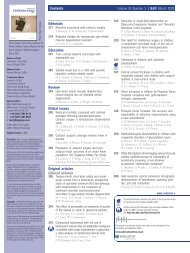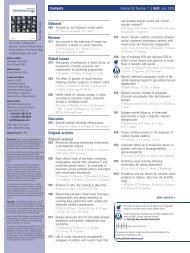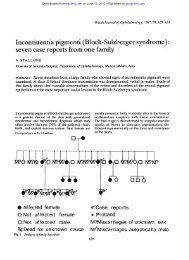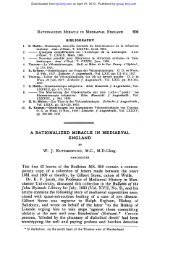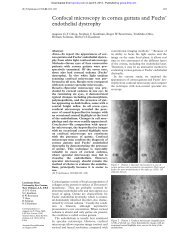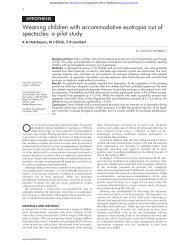USE OF MIOTICS IN SQUINT SURGERY*
USE OF MIOTICS IN SQUINT SURGERY*
USE OF MIOTICS IN SQUINT SURGERY*
Create successful ePaper yourself
Turn your PDF publications into a flip-book with our unique Google optimized e-Paper software.
Downloaded from<br />
bjo.bmj.com on March 26, 2013 - Published by group.bmj.com<br />
Brit. J. Ophtihal. (1956), 40, 96.<br />
<strong>USE</strong> <strong>OF</strong> <strong>MIOTICS</strong> <strong>IN</strong> SQU<strong>IN</strong>T <strong>SURGERY*</strong><br />
BY<br />
JOHN WHITWELL AND AUDREY PRESTON<br />
Moorfields, Westminster and Central Eye Hospital<br />
AFIER operations for convergent squint, a comparatively frequent result<br />
is that the eyes are straight for distance, but on attempting near vision, the<br />
squint reappears. It happens even after a full recession of both medial<br />
recti and after the fullest possible spectacle correction. This residual<br />
acconmmodational squint proves a great handicap to the full restoration of<br />
binocular single vision and any treatment to obviate it would be welcome.<br />
The use of atropine in such cases is widespread, with the hope that paralysis<br />
of accommodation will reduce convergence. Unfortunately, atropine does<br />
not paralyse the will to accommodate. With the eyes atropinized the effort<br />
involved in attempting to obtain a clear image (frontal accommodation<br />
reflex) can cause a vicious overconvergence. We have often witnessed this<br />
unfortunate result when the child is playing with a toy or attempting to<br />
read a " get-well-quick" card. Atropine is also unsuitable in such cases<br />
because so much of the post-operative orthoptic training, especially bar<br />
reading, requires clarity of near vision.<br />
It would seem therefore that the opposite effect upon accommodation<br />
would be of more use. Would pilocarpine, setting the accommodation for<br />
near without any voluntary effort, control this accommodational squint<br />
residue? Its use is not new, for Javal (1896) advised a young lady with a<br />
squint to use it when attending a wedding. More recently, Abraham<br />
(1949, 1952) has described the use of miotics in squints and some of the ill<br />
effects of the prolonged use of di-isopropyl fluorophosphonate, including<br />
the formation of intra-epithelial cysts of the iris.<br />
In our recent investigations, pilocarpine was used as an aid to the postoperative<br />
orthoptic training of cases that still showed a convergence for<br />
near, although for distance the eyes were straight or almost so. It was<br />
found necessary to instil the 1 per cent. drops into both eyes three times a<br />
day, and the treatment was started on the second or third day after operation<br />
as at no time were the eyes padded. Usually this was done for 4 weeks,<br />
followed by drops twice daily for 2 weeks and then once daily for a further<br />
2 weeks. This routine was varied according to the progress of the case.<br />
In successful cases, the beneficial effects were quick and dramatic. Cases<br />
that showed binocular single vision for near but with a marked tendency to<br />
break down to a convergent squint were immediately controlled as were<br />
several that were frankly convergent squints for near.<br />
The Figure (opposite) shows. this effect of pilocarpine, which assists<br />
post-operative orthoptic training.<br />
The Table (overleaf) reports the progress of the first nine cases so treated.<br />
These results show that success depends on two factors. First, good binocular<br />
Reocived for publication July 18, 1955.<br />
96
Downloaded from<br />
bjo.bmj.com on March 26, 2013 - Published by group.bmj.com<br />
<strong>MIOTICS</strong> <strong>IN</strong> SQU<strong>IN</strong>T SURGERY 97<br />
(A) Looking at near<br />
object 7 days after<br />
lateral guarded<br />
bitenotomy<br />
of medial recti.<br />
(B) Looking at near<br />
object 48 hours later,<br />
after instillation of<br />
pilocarpine.<br />
FIGURE.-Male, aged 7 years, Case 4 in Table, had had bilateral recession medial<br />
recti (5 mm.) one year before.<br />
vision with fusion and fairly good stereopsis are essential for a successful<br />
result and pilocarpine will produce no miracles when these are lacking; only a<br />
temporary reduction in the angle of squint while the drops are being used<br />
can be expected. Secondly, the residual angle of squint must not be too<br />
large, but rather as expected, there is no definite limiting angle. The<br />
failure of pilocarpine to control the residual angle can be used as a yardstick<br />
in deciding on further surgery. Even a small reduction in the Maddox<br />
wing reading may allow the squint to be controlled.<br />
Case 9, a girl aged 7 years, had a left convergent squint, first noticed at 4 years old.<br />
Visual acuity.-Right eye: 6/9 with 3 D sph., 0 5 D cyl. 900; Left eye: 6/7 5 with 2 5<br />
D sph.<br />
Pre-operative Instrument Readings.-<br />
Maddox Rod: with glasses Eso 6; without glasses Eso 30.<br />
Maddox Wing: with glasses Eso 23- without glasses Eso 36.<br />
Bilateral Visual Acuity: with glasses 6/9; without glasses alternating convergent<br />
strabismus.<br />
Bar Reading: with and without glasses-convergent squint.<br />
Synoptophore: with glasses+100; without glasses+20°, with full stereopsis.<br />
Operation.-Bilateral recession of both medial recti (5 mm.)<br />
Post-operative Instrument Readings.-<br />
Maddox Rod: with glasses Eso 6, without glasses Eso 21.<br />
Maddox Wing: with glasses Eso 11, without glasses Eso 21.<br />
Bar Reading: with and without glasses-convergent squint.<br />
Bilateral Visual Acuity: with glasses 6/9; without glasses convergent squint.<br />
Treatment.-Pilocarpine 1 per cent. drops three times daily for one month, then twice
Downloaded from<br />
bjo.bmj.com on March 26, 2013 - Published by group.bmj.com<br />
98 JOHN WHITWELL AND AUDREY PRESTON<br />
TABLE<br />
Cover Test Angle of Deviation<br />
Case Age State of (post-operative) (post-operative)<br />
No. Sex (yrs) Binocular<br />
Vision With glasses Without glasses With glasses Without<br />
glasses<br />
1 M 12 Full Dist: Nothing ab- Alternating conver- +3 +12<br />
stereopsis normal detected. gent strabismus. Rod Eso 2 Eso 15<br />
Near: latent conver- Binocular single Wing Eso 3 Eso 15<br />
gence vision with effort<br />
2 M 7 Full Dist: Nothing ab- Alternating conver- + S + 12<br />
stereopsis normal detected. gent strabismus. Rod Eso 5 Eso 20<br />
Near: latent conver- Binocular single Wing Eso 11 Eso 19<br />
gence vision with effort<br />
3 M 8 FuUl Dist: Nothing ab- Right convergent +4 +5-15<br />
stereopsis normal detected. strabismus. Bin- Rod Eso 2<br />
Near: right conver- ocular single vision Wing Eso 15<br />
gent strabismus with effort<br />
4 M 7 Fusion, Dist: latent conver- Left convergent stra- + 8 +25<br />
some gence with good bismus near and Rod Eso 6<br />
stereopsis recovery. distance Wing Eso 30<br />
Near: left convergent<br />
strabismus<br />
S F 8 Good Dist: latent conver- Dist: latent conver- +10 +12<br />
stereopsis gence, moderate gence. Rod Eso 10 Eso 19<br />
recovery. Near: left conver- Wing Eso 10 Eso 19<br />
Near: latent conver- gent strabismus<br />
gence with slow<br />
recovery<br />
6 F 4 Weak Dist: Nothing ab- Left convergent stra- +5 +20<br />
fusion normal detected. bismus near and Other readings<br />
Near: left conver- distance not taken<br />
gent strabismus<br />
7 M 7 I Weak Dist: latent conver- Left convergent stra- +8 +15<br />
stereopsis gence. bismus near and Rod Eso 10<br />
Near: left conver- distance Wing Eso 15<br />
gent strabismus<br />
8 M 6 Weak Dist:smallrightcon- Same +6 +10<br />
stereopsis vergent strabismus. Rod Eso 6<br />
Near: increasing Wing Eso 17<br />
right convergent<br />
strabismus _!<br />
9 F 7 Full Dist: nothing ab- Alternating conver- +5 + 14<br />
stereopsis normal detected. gent strabismus Rod Eso 6 Eso 21<br />
Near: small alternat- Wing Eso 11 Eso 21<br />
ing convergent<br />
strabismus<br />
daily for 2 weeks, then daily for 2 weeks. During this time, the patient was encouraged<br />
to leave off glasses for distance and was given bar reading exercises, without glasses<br />
where possible. This was continued for one month after the miotic was stopped.<br />
Final Instrument Readings.<br />
Maddox Rod: with glasses Eso 3; without glasses Eso 9.<br />
Maddox Wing: with glasses Eso 3; without glasses Eso 9.<br />
Bilateral Visual Acuity: with glasses 6/7 5; without glasses 6/7- 5<br />
Bar Reading: N.6.<br />
Synoptophore Angle: with glasses 0°; without glasses +5g.<br />
The cover test showed a slight latent convergence for near and distance without glasses.<br />
She was instructed to use her glasses for reading only.<br />
As yet, no control series has been investigated, and it could well be argued<br />
that orthoptic training would eventually give these cases full binocular single<br />
vision at all distances. It is submitted, however, that a result as shown in
Downloaded from<br />
bjo.bmj.com on March 26, 2013 - Published by group.bmj.com<br />
<strong>MIOTICS</strong> <strong>IN</strong> SQU<strong>IN</strong>T SURGERY<br />
-PROGRESS <strong>IN</strong> N<strong>IN</strong>E CASES<br />
Cover Test Angle of Deviation<br />
(under pilocarpine) (under pilocarpine) Final Result<br />
With glasses Without glasses With glasses Without<br />
glasses<br />
Nothing abnormal de- Latent convergence +3 + 10 Binocular single Success<br />
detected with slow recovery Rod Eso 2 Eso 11 vision without<br />
Wing Ortho Eso 11 glasses<br />
Nothing abnormal de- Left convergent stra- + 3 +8 Glasses for school Success<br />
tected near and bismus in extreme Rod Eso 5 Eso 15 only<br />
distance convergence only Wing Eso 5 Eso 15<br />
Dist: Nothing ab- Right convergent + 3 +7 Small latent con- Success<br />
abnormal detected. strabismus ex- Rod Eso 2 Eso 30 vergence only<br />
Near: latent conver- treme conver- Wing Eso 9 Eso 35<br />
gence with good gence only<br />
recovery<br />
Dist: nothing abnor- Left convergent stra- + 5 +18 Still tendency to Partial<br />
mal detected. bismus. Binocular Rod Eso 3 squint for near success<br />
Near: left convergent single vision Wing Eso 14 (Figure)<br />
strabismus. Binocular<br />
single vision<br />
with effort<br />
Dist: nothing abnor- Latent convergence, +4 +7 Glasses discarded Success<br />
mal detected. moderate recov- Rod Eso 7 Eso 19<br />
Near: latent conver- ery Wing Eso 7 Eso 19<br />
gence. Good recovery<br />
Dist: nothing abnor- Left convergent stra- +3 +10 Small alternating Failure<br />
mal detected. bismus near and convergent stra-<br />
Near: left conver- distance bismus with<br />
gent strabismus. glasses for near<br />
Binocular single<br />
vision.<br />
Dist: latent conver- Left convergent stra- +7 +12 Still convergent for Failure<br />
gence. bismus Rod Eso 9 near<br />
Near: left convergent Wing Eso 11<br />
strabismus<br />
Dist: mostly Binocu- Alternating conver- +5 +9 Further surgery Failure<br />
lar single vision. gent strabismus Rod Eso 9 Eso 19 advised<br />
Near: right conver- near and distance Wing Eso 9 Eso 19<br />
gent strabismus<br />
Dist: nothing abnor- Alternating conver- +3 +8 Glasses for close Success<br />
mal detected. gent strabismus, Rod Eso 6 Eso 21 work only<br />
Near: latent conver- latent convergence Wing Eso 9 Eso 21<br />
gence, good recovery with effort.<br />
the photograph will be of great assistance to the orthoptist, and will probably<br />
shorten the training period. It might help some cases to escape further surgery.<br />
Summary<br />
The use of pilocarpine drops in the post-operative treatment of squints<br />
with a residual convergence for near is described. Success can be expected<br />
only when good stereoscopic vision is present.<br />
This investigation was carried out at the Highgate Annexe of the Moorfields, Westminster<br />
and Central Eye Hospital. We wish to thank the consultant surgeons of that hospital for their<br />
co-operation.<br />
REFERENCES<br />
ABRAHAM, S. V. (1949). Amer. J. Ophthal., 32, 233.<br />
(1952). Ibid., 35, 1191.<br />
JAVAL, E. (1896). " Manuel du strabisme ", pp. 45, 81. Masson, Paris.<br />
99
Downloaded from<br />
bjo.bmj.com on March 26, 2013 - Published by group.bmj.com<br />
Email alerting<br />
service<br />
Notes<br />
<strong>USE</strong> <strong>OF</strong> <strong>MIOTICS</strong> <strong>IN</strong><br />
SQU<strong>IN</strong>T SURGERY<br />
John Whitwell and Audrey Preston<br />
Br J Ophthalmol 1956 40: 96-99<br />
doi: 10.1136/bjo.40.2.96<br />
Updated information and services can be<br />
found at:<br />
http://bjo.bmj.com/content/40/2/96.citation<br />
These include:<br />
To request permissions go to:<br />
http://group.bmj.com/group/rights-licensing/permissions<br />
To order reprints go to:<br />
http://journals.bmj.com/cgi/reprintform<br />
To subscribe to BMJ go to:<br />
http://group.bmj.com/subscribe/<br />
Receive free email alerts when new<br />
articles cite this article. Sign up in the box<br />
at the top right corner of the online article.


